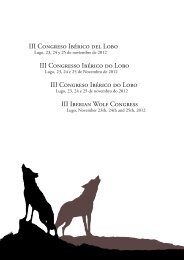Bison-Rewilding-Plan-2014
Bison-Rewilding-Plan-2014
Bison-Rewilding-Plan-2014
- No tags were found...
Create successful ePaper yourself
Turn your PDF publications into a flip-book with our unique Google optimized e-Paper software.
3. <strong>Bison</strong> pre-release management in theacclimatisation zone and semi-wild reserveDuring the acclimatisation period, the animals aregiven the opportunity, under close surveillance, torecover from the stress of capture and transportand adjust to their new surroundings. They shouldbe allowed to enter the handling area at their ownpace and should not be forced into it, as this maycause unnecessary stress. The gates of the handlingarea should be regularly closed to habituate theanimals to this procedure.In general, the European bison, as a herbivore,herd and prey species, does not present a risk topeople. However, it is a large, powerful animal and ifit is in a stressful situation and unable to take flight,it will defend itself; like almost every animal. Greatcare must therefore be taken with handling bison incaptivity, especially in small areas e.g. the handlingarea. Although bison can become quite habituatedto human presence and can give the appearanceof being docile, it should be noted that they canbecome aggressive and dangerous when stressed.Although <strong>Rewilding</strong> Europe will aim tominimise interactions with bison at all stages of arelease, there will be a certain amount of handlingin the pre-release phases (during transportationand in the acclimatisation zone and semi-wildreserve) which will be unavoidable, but for whichwe have therefore established the following guidelines.Transport3.1Transportation of European bison traditionallytakes place using wooden boxes; however, thesehave a few disadvantages:• Each box needs to be made individually to fit theanimal, as it cannot be too small, but likewise,if the box is too big the animal can turn, whichcan be fatal as it can get stuck.• The bison can easily become overheated in the box.• The boxes do not provide the animal with muchspace, and therefore it is unsuitable for longjourneys. Animals can remain in the box for amaximum of two days.• The boxes are expensive to produce.• It is difficult to observe the animal once in the box.Due to the size of the European bison, the use ofa crate is generally not recommended for transportingbison; rather, a trailer is preferable. Whentransporting bison in a trailer, animals shouldbe single-stalled and compartments should beportioned in such a way that the animal hasenough room to lie down, stand up and turnaround easily. Too much space allows the animalto produce speed, potentially injuring itself as wellas being thrown though the compartment duringextreme breaking of the truck etc.Food and water must be provided for animalsduring transit. Because animals are likely to beexcitable or even aggressive, it is best to affix awater container in the compartment ahead of time.Bedding, ideally straw, should be placed in thetrailer in order to provide traction, warmth duringcold weather, absorption of urine and faeces, andto reduce abrasions. Transport of bison in eitherhot or cold extremes is not recommended. While itis possible to improve cold conditions by providingample bedding in a trailer, the transport of bisonshould not be undertaken at prolonged temperaturesbelow 0ºC. Journeys should also not beundertaken at ambient temperatures above 25ºCas the temperature inside a trailer can be severaldegrees warmer and rapidly increase if the traileris stationary. As such, trailers should never be leftimmobile for prolonged periods of time in directsunlight. A darkened trailer is most appropriatefor transport of bison, as this reduces the effects ofvisual stimuli. Because capture and transport arestressful events, ambient noise during transportshould be minimised.Although in general, bison should be in singlestalls within a trailer, it is possible to place a cowand its calf in the same compartment, dependingon their size and temperament. Young animalsunder two years of age and from the same herdmay also be transported in one compartment,however single stalls are preferred. It is importantto consider the accessibility for a handler/veterinarianduring transport and for personnel to beable to clearly see the animal during transport inorder to check its condition. A handler will need tohave access to a small opening in order to replenishwater and/or food, as well as to administer drugs(narcotic, reversal agents, tranquillisers, etc.) ormedical treatment while the animal is confined.53



